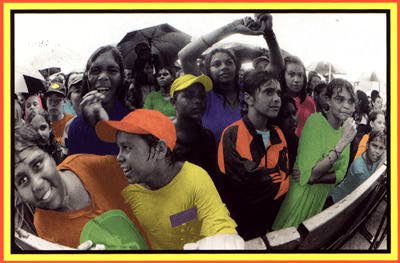
Survival'99 photo album
|
The annual Survival Festival Concert is a national celebration of Aboriginal
and Torres Strait Islander music, performance, visual art and culture.
Survival embraces and displays a vast array of Indigenous creative talent,
and provides an exciting alternative to the official Australia Day event's
calendar. Held for the first time at Waverley Oval, Bondi in 1998, Survival
has become NIAAA's most significant flagship event. In 1988, the area of
La Perouse, the scene of the first 6 Survival concerts, was host to the
biggest Aboriginal demonstration in Australian history - the 'March for
Freedom, Justice and Hope'. Survival concerts have annually built on the
positive actions that arose on that day, celebrating Aboriginal and Torres
Strait Islander peoples' survival and culture.
10 years on, Survival '98 turned out to be great day and a great cultural success, despite the threat of inclement weather. The event included performances by leading established and new artists providing audiences with examples of the best of Aboriginal and Torres Strait Islander music, song, stories and dance. Audience participants enjoyed a chance to experience bush tucker and Indigenous arts and crafts with Sydney and interstate based Aboriginal organisations. At this difficult time in Aboriginal and Torres Strait Islander affairs, the Survival event brings a positive focus to and for Aboriginal and Torres Strait Islander people and culture. The true meaning of Survival was clearly evident in the determination of the performing artists and audience members to be present at this remarkable event. When you consider that many performers and participants travelled from such areas as the Kimberleys, Northern Territory, Queensland, Victoria, South Australia and regional New South Wales, it is easy to understand why the showcasing of new Indigenous talent embodies the spirit of survival and the regeneration of Indigenous art and culture. For the thousands who flock to this national Indigenous day of celebration, this is the experience of Survival. The final line up for the Survival '98 Concert and Festival was:
Outcomes: Survival -
It is evident from feedback, media response and performers' comments that the Survival Festival Concert is a highly professional event, promoting an awareness of Indigenous culture and in particular music and dance. Clearly the event's most positive outcome was the unconditional support offered by performers. Many artists appeared at the '98 event despite many obstacles, some contributing financially to ensure their presence. The Pigram Brothers travelled all the way from Broome with their children, who also performed as The Little Piggies. Tribal Link travelled from Rockhampton, NokTuRNL from Alice Springs and Black Fire from Melbourne, while newly crowned Golden Guitar winner Troy Cassar-Daley stepped off a plane direct from the Tamworth Country Music Awards. The Survival concert provided a clear opportunity for audience development with young Aboriginal and Torres Strait Islander bands and individual performers having a chance to perform in front of an audience of 8-10,000 people. In the case of Troy Casslar-Daley, performing at the Survival concert brought special interest from the media, resulting in a series of radio and television interviews and performances. Survival '98 was bound to be a success, given the support and endorsement received from Indigenous and non-Indigenous music industries. Previously, Survival has been described as an exciting alternative to the official Australia Day event's calendar. Not only did Survival '98 receive unequivocal support from the Aboriginal and Torres Strait Islander music industry and communities, but also received enquiries for participation from national non-Indigenous and international Indigenous recording artists of notable stature. In review, the most satisfying and exciting of all were responses from audience members via telephone and written communication and statements by leading Aboriginal and Torres Strait Islander performers. "Today is about re-affirming our culture through singing and telling
stories, like we always have. Today is about being proud to be an Aboriginal
Australian. We have a right to be hear and we are strong."
"We have a lot of talent in our communities and, if given the opportunity,
they can do great things."
"This line-up showed that Indigenous music can be anything that Indigenous
people want it to be. We make it our own.... Even if they're doing rap
or reggae, they're rapping and reggaeing about Indigenous issues, with
Indigenous accents."
To publicise and promote the 1998 concert, specific media avenues were targeted including mainstream and alternative music media, all street papers, performance art print media and the general radio, television and print media. Survival provides an opportunity to performers to gain exposure in the mainstream media present in Sydney and access to international tourism networks. For example, NIAAA facilitated the Central Australian Aboriginal Media Association's (CAAMA) filming of segments of Survival '98 for inclusion in their "Corroboree Rock" special that was broadcast in Central Australia and nationally over the Tanami network. Promotion of the special was to include all communities, tourist destinations and incoming international flights. NIAAA is committed to ensuring that the Survival concert provides the Indigenous music industry with opportunities for audience development. This commitment is evident in the balance of artists chosen to participate in the concert including emerging talent and select established artists providing increased opportunities for media coverage and subsequently, developed audience awareness. NIAAA realises the potential and importance of the Survival concert and is committed to ensuring its future as a major Aboriginal and Torres Strait Islander cultural event. To this end, NIAAA will capitalise on the newly established level of professionalism observed with the 1998 concert. This strategic change will assist the Association and Survival team to more adequately tailor the event to its expanding audiences and enormously talented Indigenous musicians and performers. The NIAAA's 1999-2001 strategic plan will incorporate Survival concerts up to the year of the Federation Centenary. |
